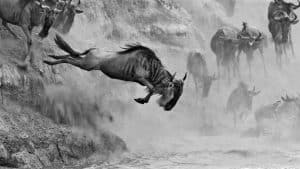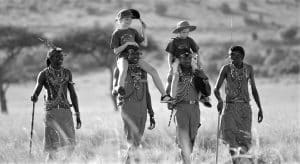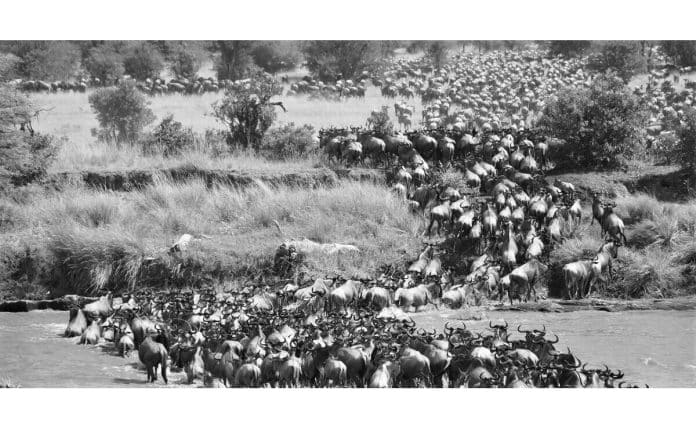Unveiling the Wonders of Nature: Discover the Thrilling Wildebeest Migration from Kenya to Tanzania
Every year, a remarkable event takes place in the heart of Africa, captivating nature enthusiasts from around the world. Welcome to the thrilling wildebeest migration, an awe-inspiring natural spectacle that unfolds between Kenya and Tanzania. As millions of wildebeest trek across the grasslands in search of greener pastures, the air becomes charged with anticipation, and the ground trembles beneath their hooves. This extraordinary migration, driven by survival instincts, is an unforgettable showcase of the sheer force and determination of these magnificent beasts.
From the Serengeti National Park in Tanzania to the Maasai Mara National Reserve in Kenya, this epic journey covers over 1,800 miles, filled with dramatic river crossings, dangerous predators, and breathtaking landscapes. Witnessing this grand procession of wildebeest, accompanied by zebras and other grazing animals, is a humbling experience that reminds us of the incredible wonders of the natural world.
Join us as we step into the heart of Africa and unveil the mysteries of the wildebeest migration from Kenya to Tanzania. Embark on a virtual safari and immerse yourself in the vibrant sights and sounds of the wild. Whether you’re an ardent wildlife enthusiast or simply seeking a thrilling adventure, this is a journey you won’t want to miss. Pack your virtual bags, and let’s explore this extraordinary spectacle together.
The Significance of the Kenya-Tanzania Migration Route
The wildebeest migration from Kenya to Tanzania is not only a natural wonder but also a crucial aspect of the African ecosystem. The migration route provides vital resources to numerous species and supports the delicate balance of life in the region. The wildebeest, also known as the gnu, play a crucial role in maintaining the grasslands’ health by grazing on the vegetation, preventing it from becoming overgrown and allowing for new growth.
The migration also serves as a major tourist attraction, boosting the local economies of Kenya and Tanzania. It draws in visitors from all over the globe, who come to witness this incredible display of nature’s power and resilience. The tourism industry helps to fund conservation efforts and supports local communities, creating a sustainable model for preserving this natural heritage for future generations.
The Kenya-Tanzania migration route holds immense cultural significance as well. Indigenous tribes, such as the Maasai, have coexisted with the wildlife in these lands for centuries, and their traditional way of life is deeply intertwined with the wildebeest migration. The annual arrival of the herds marks a time of celebration and harvest, with rituals and ceremonies that honor the relationship between humans and nature.
Timing of the Wildebeest Migration
The timing of the wildebeest migration from Kenya to Tanzania is a carefully orchestrated dance of nature, driven by the changing seasons and the availability of food and water. It is a cyclical journey that repeats itself year after year, as the herds follow the rainfall patterns and the growth of fresh grass.
The migration typically begins in the Serengeti National Park in Tanzania around December, where the wildebeest graze on the nutrient-rich plains. As the dry season approaches, they start moving northwest, crossing the Mara River into the Maasai Mara National Reserve in Kenya. This river crossing is one of the migration’s most dramatic moments, as the wildebeest face treacherous currents and lurking crocodiles.
By July, the herds have spread across the Maasai Mara, taking advantage of the abundant grazing opportunities. As the rains return to the Serengeti, usually around October, the wildebeest begin their journey back south, completing the cycle. The exact timing of the migration can vary slightly each year, depending on weather patterns and other factors, but the general pattern remains consistent.
The Great Migration: A Journey of Survival

The wildebeest migration from Kenya to Tanzania is not merely a sightseeing adventure; it is a life-or-death journey for these animals. The vast herds face multiple threats along the way, from predators to treacherous river crossings. Survival instincts drive their every move, and only the fittest and luckiest individuals make it to the end of the journey.
One of the biggest challenges the wildebeest faces is the presence of predators, such as lions, cheetahs, and hyenas. These predators follow the herds closely, waiting for the opportune moment to strike. The vast number of wildebeest offers protection in numbers, but the weak, young, and injured are often targeted. The migration becomes a constant battle between life and death, with predators lurking in the shadows and the wildebeest staying on high alert.
Another perilous obstacle the wildebeest encounter is the river crossings. The Mara River, in particular, poses a significant risk. The strong currents can sweep away weaker individuals, and the riverbanks are inhabited by crocodiles lying in wait. The wildebeest must summon their courage and make split-second decisions to leap into the river, hoping to reach the other side safely. The river crossings are a spectacle in themselves, with dust, noise, and adrenaline filling the air.
Despite the challenges, the wildebeest migration is a testament to the resilience and adaptability of these animals. It is a reminder of the delicate balance of life in the African savannah and the intricate web of relationships that exist between different species. Witnessing this epic journey is a humbling experience that leaves a lasting impression on all who have the privilege to observe it.
Witnessing the Wildebeest Migration: Best Viewing Spots

Experiencing the wildebeest migration from Kenya to Tanzania firsthand is an adventure like no other. There are several prime viewing spots along the migration route that offer unparalleled opportunities to witness this natural spectacle up close. Whether you prefer the vast plains of the Serengeti or the rugged beauty of the Maasai Mara, there is a location to suit every adventurer’s taste.
In Tanzania, the Serengeti National Park is the best place to catch the wildebeest herds during the early stages of the migration. The wide-open grasslands provide an unobstructed view of the vast herds as they graze and gather strength for the long journey ahead. The Seronera region, in the central part of the park, is particularly renowned for its abundant wildlife and picturesque landscapes.
As the migration progresses, the focus shifts to the Maasai Mara National Reserve in Kenya. The Mara River crossings are the highlight of this stage, as the wildebeest navigate the treacherous waters. The Mara Triangle, located on the western side of the reserve, offers excellent vantage points for witnessing these dramatic river crossings. The expansive plains of the reserve also provide ample opportunities for observing predators in action, as they stalk their prey amidst the wildebeest herds.
For a more off-the-beaten-path experience, the Grumeti Game Reserve in Tanzania offers a unique perspective on the migration. Situated between the Serengeti and the Maasai Mara, this private reserve provides exclusive access to the wildebeest herds and allows visitors to witness the migration in a more secluded setting. The Grumeti River is another key crossing point and is known for its resident crocodile population, adding to the thrill of the experience.
No matter which viewing spot you choose, timing is crucial. Researching the migration patterns and consulting with local guides will help you plan your visit during the peak migration periods. It is advisable to book accommodations well in advance, as these popular locations tend to fill up quickly during the migration season.
Planning Your Wildebeest Migration Safari
Embarking on a wildebeest migration from Kenya to Tanzania safari requires careful planning to ensure a smooth and memorable experience. Here are some essential tips to help you make the most of your adventure:
- Choose the right time: The migration is a year-round phenomenon, but the river crossings and the peak herds are usually seen between July and October. Research the best time to visit based on your preferences and the specific stage of the migration you wish to witness.
- Book your accommodations early: As the migration attracts a large number of visitors, accommodations can fill up quickly. Secure your lodging well in advance to avoid disappointment.
- Hire a professional guide: To maximize your chances of witnessing the migration up close and personal, consider hiring a knowledgeable guide who can navigate the vast wilderness and provide valuable insights into the animals’ behavior.
- Pack appropriate gear: Be prepared for varying weather conditions and pack accordingly. Comfortable clothing, sturdy footwear, sunscreen, insect repellent, and a good pair of binoculars are essential.
- Respect the wildlife and the environment: Remember that you are a guest in the animals’ natural habitat. Follow the guidelines provided by your guide and the park authorities, and maintain a safe distance from the animals to ensure their well-being and your own safety.
By planning ahead and being well-prepared, you can ensure a fulfilling and unforgettable wildebeest migration safari.
Tips for Capturing Stunning Photos of the Migration

The wildebeest migration from Kenya to Tanzania presents endless opportunities for capturing breathtaking photographs. Here are some tips to help you capture the essence of this extraordinary spectacle:
- Invest in a good telephoto lens: A telephoto lens with a long focal length will allow you to capture close-up shots of the wildebeest and other animals from a distance, without disturbing their natural behavior.
- Experiment with different angles: Get creative with your composition by capturing the migration from various angles. Try shooting from a low perspective to emphasize the scale and power of the herds, or experiment with aerial shots to capture the grandeur of the landscape.
- Use natural light to your advantage: The soft, warm light during the golden hours of sunrise and sunset can add a magical touch to your photographs. Take advantage of the gentle lighting conditions to capture the wildebeest in all their glory.
- Focus on storytelling: Use your photographs to tell a story about the migration. Capture the drama of the river crossings, the interactions between different species, and the sheer magnitude of the herds in motion.
- Be patient and observant: The wildebeest migration is a dynamic and ever-changing spectacle. Take the time to observe the animals’ behavior and anticipate their movements to capture the most captivating moments.
Remember, photography is not just about capturing technically perfect images but also about conveying emotions and telling a story. Let your passion for the wildebeest migration shine through your photographs.
Conservation Efforts to Protect the Wildebeest Migration
The wildebeest migration faces numerous threats, including habitat loss, illegal hunting, and climate change. To ensure the survival of this natural wonder, various conservation initiatives have been implemented in both Kenya and Tanzania.
National parks and reserves, such as the Serengeti National Park and the Maasai Mara National Reserve, play a crucial role in protecting the migration route. These protected areas provide a safe haven for the wildebeest and other wildlife, ensuring their continued survival.
International organizations, such as the World Wildlife Fund (WWF) and the African Wildlife Foundation (AWF), work closely with local communities and governments to conserve the migration. They support community-based conservation projects, promote sustainable tourism practices, and raise awareness about the importance of preserving this unique natural heritage.
Tourism also plays a significant role in conservation efforts. The revenue generated from wildlife tourism helps fund conservation initiatives, supports local communities, and provides economic incentives for protecting the migration route.
By supporting responsible tourism practices, staying informed about the challenges facing the migration, and contributing to conservation efforts, travelers can play a vital role in safeguarding this natural wonder for future generations.
Cultural Experiences During the Wildebeest Migration

The wildebeest migration not only offers a chance to witness the wonders of nature but also provides a unique opportunity to immerse oneself in the rich cultural heritage of Kenya and Tanzania. Indigenous tribes, such as the Maasai, have a deep connection with the land and the animals, and their traditions and customs are an integral part of the migration experience.
Visitors can engage in cultural activities, such as visiting Maasai villages and learning about their way of life. Participating in traditional dances, listening to stories passed down through generations, and trying local cuisine are all ways to gain a deeper understanding of the local culture and its close ties to the wildebeest migration.
Cultural tourism initiatives, led by local communities, offer authentic and immersive experiences that benefit both travelers and the local economy. By supporting these initiatives, visitors can contribute to the preservation of cultural heritage and promote sustainable tourism practices.
An Unforgettable Adventure
The wildebeest migration from Kenya to Tanzania is a testament to the power, resilience, and interconnectedness of the natural world. It is a journey of survival, a spectacle of raw beauty, and a cultural celebration. Witnessing this extraordinary event is an experience that will leave you in awe and remind you of the wonders that exist beyond the boundaries of our everyday lives.
So, whether you embark on a physical safari to witness the migration or embark on a virtual journey through captivating stories and photographs, let the wildebeest migration inspire you to appreciate the incredible diversity and harmony of the natural world. Take a moment to pause, listen to the rumbling hooves, and marvel at the courage and determination of these magnificent creatures. The wildebeest migration is a profound reminder that in the grand tapestry of life, we are all connected.
For more articles related to Things to Do in Tanzania (Zanzibar), click here!


































